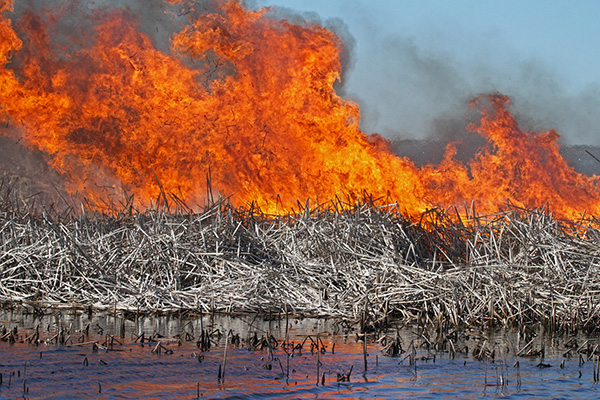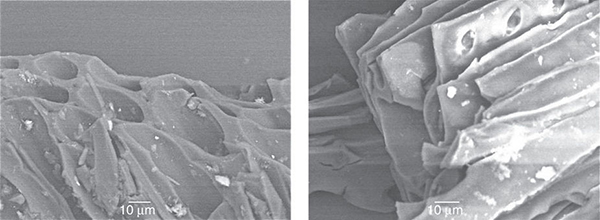
by Laura Reynolds Thursday, August 17, 2017

Rising atmospheric oxygen levels may have spurred wildfire activity and helped bring an end to a bout of ocean anoxia about 180 million years ago. Credit: Chuck Hanlon, South Florida Water Management District, CC BY 2.0
Many times throughout Earth’s history, oxygen levels in the world’s oceans have decreased dramatically in episodes called oceanic anoxic events (OAEs), which have caused massive marine die-offs. In the Early Jurassic, for example, the Toarcian OAE has been linked with the extinction of many ammonite species and other sea life. However, how such episodes end remains largely unclear to scientists.
In a new study in Nature Communications, researchers examining fossilized charcoal in roughly 180-million-year-old ocean sediments have found that wildfire activity — indicative of atmospheric oxygen levels — increased toward the end of the Toarcian OAE. This work provides the first fossil-based evidence that rising atmospheric oxygen might have helped end the OAE, which is thought to have lasted roughly 1.7 million years.
“It takes a long time for the earth system to rebalance” after an OAE, so it’s important to understand what causes these events to come to a “natural end,” says Sarah Baker, a doctoral candidate at Exeter University in England and lead author of the study.
Baker says OAEs “represent large perturbations, or shifts, in the carbon cycle,” in which concentrations of carbon dioxide in the atmosphere rise due to intense volcanism or other sources. The greenhouse gas causes Earth to warm, and warmer ocean waters hold less oxygen and circulate it less efficiently. Additionally, warmer air temperatures increase precipitation, which weathers rock and washes sediment and nutrients from land into the ocean. The added nutrients allow ocean life, particularly microorganisms like plankton, to flourish. When these organisms die, the bacteria that decompose them consume oxygen, so with warmer ocean waters and excess populations of microorganisms come declining oxygen levels in the ocean.
Booming plankton populations also mean that organic matter is buried more rapidly during OAEs. This rapid burial of the microorganisms’ carbon-rich remains in the deep ocean outpaces the rate of decomposition. Therefore, atmospheric oxygen that would normally have mixed back into the surface ocean and been consumed in breaking down this organic matter slowly builds up in the atmosphere.

These tiny charcoal fragments were found in shale from Portugal that dates to the time of Toarcian oceanic anoxic event. Credit: Baker et al. Nature Communications, May 2017, CC BY 4.0
“Fire is sensitive to very small changes in atmospheric oxygen,” Baker says. When atmospheric oxygen levels rise, fuel is more easily combusted, so wildfire activity, along with charcoal production, increases. The shales that Baker and her colleagues studied — from Wales and Portugal — contain fossil charcoal deposited by wind and rivers in ancient ocean sediments before, during and after the Toarcian OAE. The team used the shales to test for relationships between atmospheric oxygen (as represented by charcoal abundance) and OAE termination.
The researchers found that charcoal abundances began increasing about 1 million years after the OAE started and stayed elevated for about 800,000 years, peaking near the end of the OAE. The results support previously published models that suggested that anoxic ocean conditions would cause increases in atmospheric oxygen, Baker and her team wrote. They also noted that the return of charcoal concentrations to background levels following the OAE could reflect that increasing wildfire activity eventually suppressed oxygen-producing photosynthesis by terrestrial vegetation enough that atmospheric oxygen levels decreased back to pre-OAE levels.
The new research addresses a fundamental lack of understanding of what regulates oxygen concentrations in the atmosphere, says Lee Kump, a geoscientist at Penn State University who was not involved in the study. Scientists have ideas about possible mechanisms, Kump says, but “we really don’t understand why atmospheric oxygen levels don’t go sky high, or why the atmosphere doesn’t run out of oxygen.”
In addition to showing that fire feedbacks are part of Earth’s self-regulatory system for atmospheric oxygen, the researchers contend that the buildup of atmospheric oxygen during the Toarcian OAE played a central role in bringing the oceans out of anoxia. This occurred, they suggested, through direct mixing of oxygen from the air back into the ocean, and as a result of decreasing nutrient flow into the ocean. They suggest that as fires killed off vegetation on land, plant-driven weathering processes, which make phosphorus available for ocean life, may have decreased. Marine life, limited by a lack of nutrients, no longer consumed all the oxygen through respiration and/or decomposition, allowing oxygen concentrations to increase once again in ocean waters.
However, Kump notes that the termination of the Toarcian OAE coincided with a change to a cooler and drier global climate. Therefore, he says, an alternative interpretation is that “the termination of the OAE is just related to the reduction of volcanism and the restoration of the climate system … and that’s ultimately what leads to the re-oxygenation of the deep ocean.” As the climate cools, the ocean can hold more gas and circulate it more efficiently to the deep ocean, he says. There would also be less precipitation, meaning less nutrient input to the oceans, all of which allow oxygen to increase in ocean waters. Kump says he thinks that the buildup of atmospheric oxygen likely played a role in re-oxygenating the oceans, but that direct mixing of atmospheric oxygen into the ocean was “more or less a secondary effect” in terminating the OAE.
Baker adds that the elevated charcoal levels seen in the shales lasted almost a million years. This is similar to the timescale over which significant changes in atmospheric oxygen are expected to occur, she says, which supports an atmospheric oxygen driver for the OAE termination. However, she agrees that a combination of events, including the reduction in volcanism, as well as rising oxygen aided in terminating the Toarcian oceanic anoxic event. She suggests that future research should focus on charcoal records from other time periods to test whether rising atmospheric oxygen levels played a role in terminating other OAE events.
© 2008-2021. All rights reserved. Any copying, redistribution or retransmission of any of the contents of this service without the expressed written permission of the American Geosciences Institute is expressly prohibited. Click here for all copyright requests.